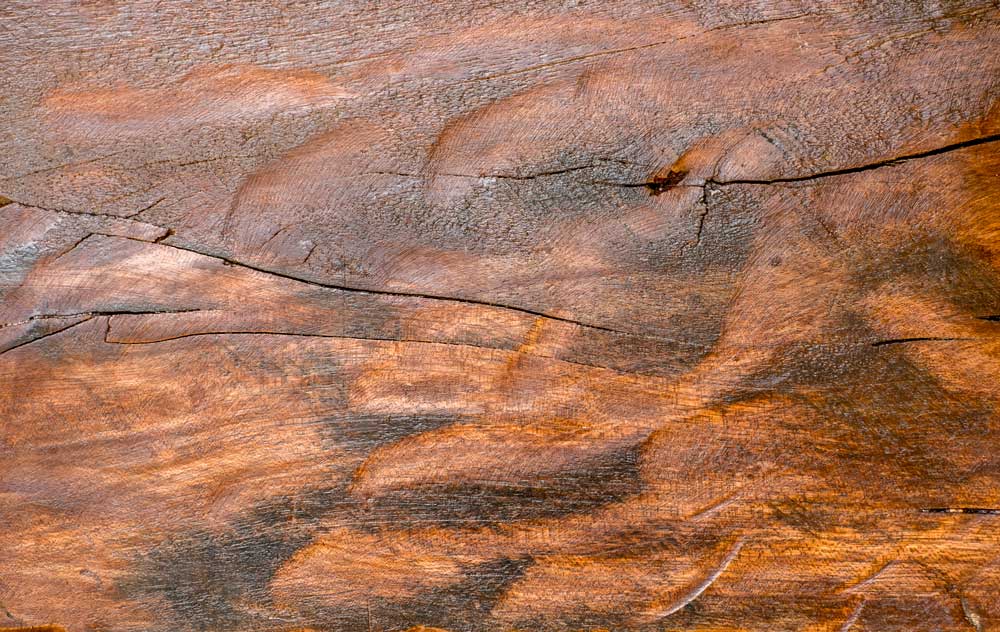Introduction: The Hidden Threat of Mold on Hardwood Floors
Hardwood floors have long been the epitome of sophistication and timeless elegance, transforming homes with their warm tones and natural beauty. They ooze charm and resilience, but beneath their polished finish lurks a hidden adversary: mold. This microscopic enemy, often unseen, can infiltrate the tiny cracks and crevices in your hardwood floors, thriving within the moist, dark environment. Unaddressed, mold under hardwood floors can pose serious health risks and compromise the structural integrity of your flooring. In this article, we’ll unravel the mystery of hardwood floor mold damage, examine its causes, and provide you with practical advice on identification, removal, and prevention. With the right knowledge and timely action, you can preserve the beauty of your hardwood floors while safeguarding your health and comfort.
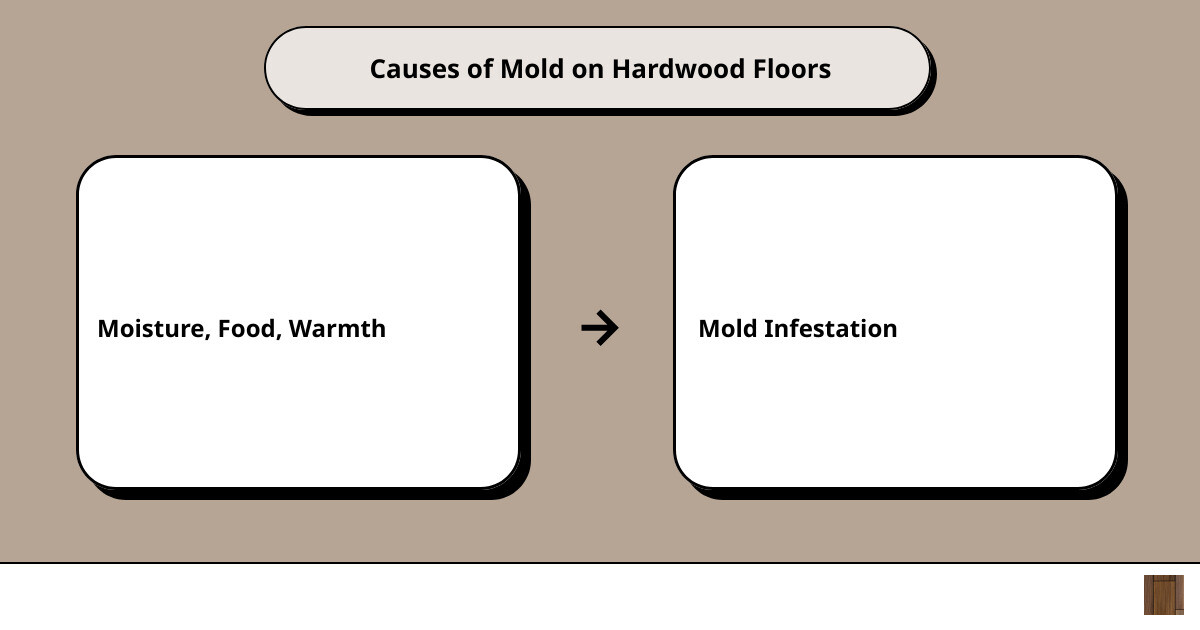
Understanding the Causes of Mold on Hardwood Floors
Discovering mold on your hardwood floors can be a worrisome experience. Understanding the causes of this common issue can help you prevent it in the future and take swift action when necessary.
The Role of Moisture in Mold Growth
The first and most crucial factor in mold growth is moisture. Mold spores thrive in damp environments. When moisture seeps into the cracks and crevices of your hardwood floors, it creates an ideal breeding ground for mold. This can happen due to a range of factors, such as water leaks, high humidity, or even just walking around after a shower. Regularly allowing your hardwood floors to remain wet could potentially increase the chances of mold forming underneath.
How Food and Warmth Contribute to Mold Infestation
In addition to moisture, mold needs organic material to feed on. This could be anything from breadcrumbs dropped on the floor to the very wood that makes up your flooring. Mold feeds on these materials, growing and spreading across your floor.
Warmth is another key player in this scenario. Mold prefers warm environments, which makes your cozy home an attractive spot for it. In these conditions, mold can develop and proliferate, leading to a full-blown infestation if not addressed promptly.
To keep your hardwood floors mold-free, you’ll need to control these three factors to the best of your ability. Reduce moisture by promptly cleaning spills, enhancing ventilation, and using a dehumidifier if necessary. Regular floor cleaning can help eliminate food sources for mold, and while you can’t alter your home’s temperature drastically to deter mold, awareness of this factor will help you better manage mold risk.
In the following sections, we will delve deeper into identifying mold, effective removal methods, and preventive measures to keep your hardwood floors pristine and mold-free.
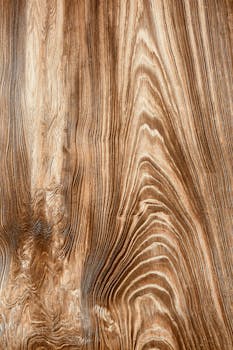
Identifying Mold on Your Hardwood Floor
Mold can be a deceitful enemy, often hiding in plain sight or beneath the surface of your hardwood floors. The first step towards combating this silent invader is to know what to look for and how to identify it.
Recognizing the Appearance of Mold on Hardwood
Mold is not a uniform fungus; it can manifest in various colors and forms. However, the most common type of mold found on hardwood floors is Aspergillus, which usually appears as a dark or black discoloration on the wood.
Another cue to watch for is any unusual staining or discoloration on your hardwood floor. If parts of your floor appear darker or have strange spots, this could be an indicator of mold growth beneath the surface.
Mold growth can also lead to physical changes in your hardwood floor. If you notice any warping, buckling, or peeling finish, these could be signs of moisture trapped between the planks and the subfloor, leading to mold growth.
Symptoms of Mold Exposure and Other Indicators of Infestation
Mold doesn’t always make its presence known visually. Sometimes, the first sign of a mold infestation is the impact it has on your health. The presence of mold can trigger symptoms like breathing difficulties, itchy eyes, headaches, and difficulty concentrating. If you or your family members start experiencing these symptoms without any apparent cause, it might be a sign of mold hiding beneath your floors.
Another subtle sign of mold is a persistent musty smell. Mold produces gases known as microbial volatile organic compounds (MVOCs), which have a distinctive, unpleasant odor. If you catch a whiff of this musty scent, it could indicate a fungal infestation in your home, possibly under your hardwood floors.
The Dangers of Mold Under Hardwood Floors
Mold is not just an aesthetic issue; it poses significant risks to both your property and health. As it grows, mold can eat away at the wood, causing structural damage and potentially ruinous repair costs.
Even more concerning are the health risks associated with mold exposure. Aspergillus, the most common type of mold on hardwood floors, can cause severe respiratory illnesses and hypersensitivity reactions if left untreated.
Mold exposure can also lead to long-term health issues. It can trigger allergic reactions, worsen asthma symptoms, and in severe cases, can lead to more serious respiratory conditions.
In the next section, we’ll discuss effective methods for removing mold and how to restore the health and beauty of your hardwood floors.
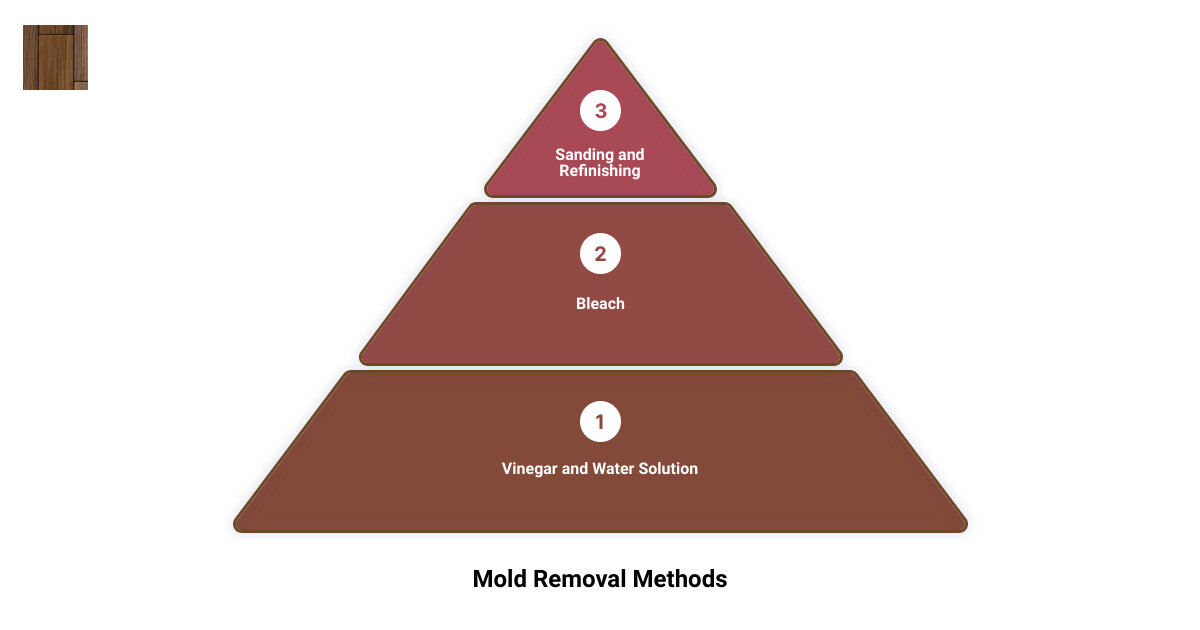
Effective Methods for Removing Mold from Hardwood Floors
Just discovered mold on your hardwood floor? Don’t panic! There are several effective methods to remove mold and restore the natural beauty of your hardwood floors. Let’s dive into the details.
Using Vinegar and Water Solution for Surface Mold
One of the most effective and natural ways to get rid of surface mold is by using a vinegar and water solution. Mix equal parts of vinegar and warm water in a spray bottle and spritz it onto the mold. Let it dry for about an hour before wiping the surface with a moistened cloth and then a dry towel. The acidity in the vinegar penetrates the mold and kills it. And the best part? It’s safe for your hardwood floors and won’t cause any harm or discoloration. Just remember, it’s crucial to let your floors air-dry completely before walking on them to prevent any moisture damage.
The Role of Bleach in Killing Mold Spores
While vinegar is effective for surface mold, when it comes to mold that has penetrated the wood, bleach comes into play. Dilute bleach in water at a ratio of 8:1, and spray it on the affected area. After letting it sit for a few minutes, wipe off the bleach with a rag. Be careful not to leave the bleach on for longer than necessary as it can damage the wood finish. This method not only kills live mold but also prevents future outbreaks.
When to Consider Sanding and Refinishing Your Hardwood Floor
Sometimes, mold can penetrate deep into the wood, making it difficult to remove completely with solutions. In such cases, sanding and refinishing the hardwood floor can be an effective method. Begin by using 100 grit sandpaper or a metal hand scraper to remove as much mold as possible, then use finer 220 grit sandpaper for deeply ingrained mold. Once you’ve removed all the mold and the floor is dry, apply a coat of wood finish to restore the original look of your floor.
Just remember: when dealing with mold, always wear protective equipment like a mask and gloves to prevent inhaling mold spores, which can be harmful to your health.
In the next section, we’ll discuss when it’s time to call in the experts for professional mold removal services. Stay tuned!
Professional Assistance: When to Call in the Experts
When it comes to mold on your hardwood floor, sometimes the situation calls for more than vinegar and a thorough cleaning. The key is recognizing when your mold situation has escalated beyond a DIY project and become a job for professionals.
Determining the Extent of Mold Damage
Mold can be sneaky, growing beneath the surface of your hardwood floors, hidden from view. If you notice persistent musty odors, worsening allergy symptoms, or visible dark spots spreading across your floor, it’s time to consider professional assistance. These signs may indicate the presence of extensive mold damage that has penetrated deep into the wood, requiring more than just surface treatment.
The Benefits of Professional Mold Removal Services
Professional mold removal services offer expert knowledge and specialized equipment to handle mold infestations thoroughly and safely. They can accurately assess the extent of the mold damage and devise an effective course of action to remove it. Professionals are trained to handle severe mold infestations, reducing the risk of mold spores spreading throughout your home and protecting your health.
Moreover, professional services save you valuable time and effort, ensuring a thorough cleaning and treatment process that can achieve more long-lasting results than DIY methods. They also provide a protective finish that keeps your floors shiny and new-looking for a longer time, saving you from frequent repairs and replacement.
California Flooring & Design: Your Partner in Mold Damage Restoration
When the situation calls for professional assistance, you can count on California Flooring and Design. Not only do we specialize in high-quality hardwood flooring and installation, but we also understand the unique challenges of dealing with hardwood floor mold damage.
Our team is equipped with the necessary tools and expertise to effectively remove deep-set mold from hardwood floors, ensuring your floor’s natural beauty is restored and protected. We’re here to help you navigate this complex problem, providing professional, reliable service you can trust.
Remember, addressing mold damage promptly is crucial to prevent further complications and ensure a safe living environment. If you’re dealing with hardwood floor mold damage, don’t delay—reach out to California Flooring and Design today.
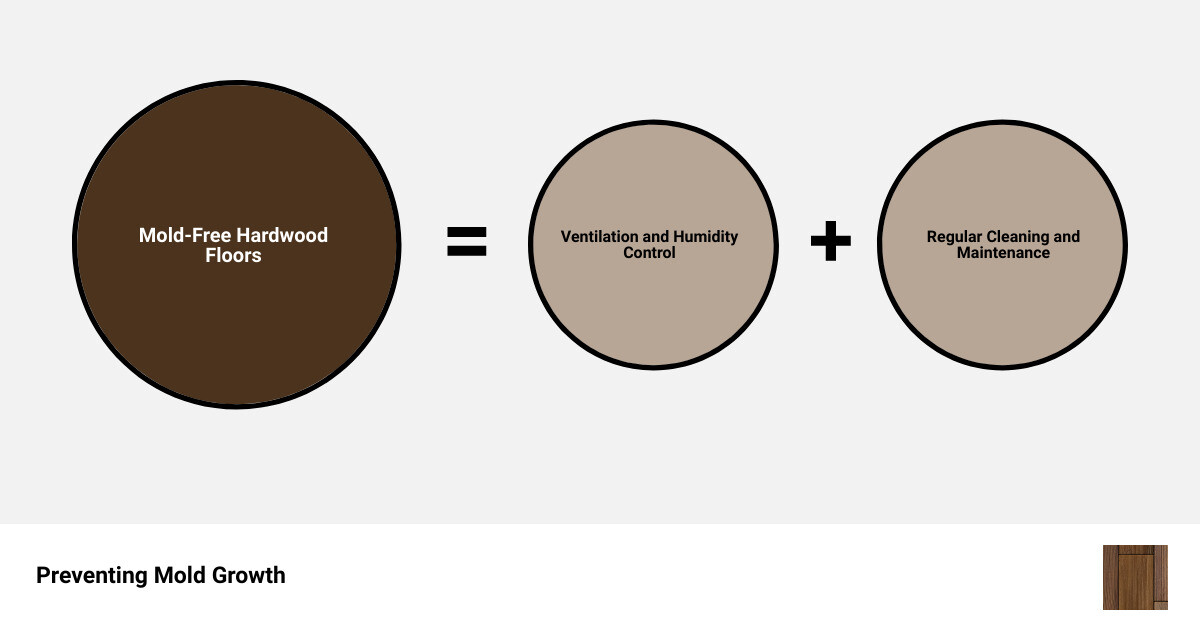
Preventing Future Mold Growth on Hardwood Floors
While mold on your hardwood floors can be a daunting issue, it is certainly preventable. Ensuring that mold doesn’t make a comeback to your elegant hardwood floors involves three key steps: maintaining proper ventilation and humidity control, conducting regular cleaning and maintenance, and promptly addressing any water leaks or moisture issues.
Importance of Ventilation and Humidity Control
The first line of defense against mold is creating an environment in which it can’t thrive. Excess moisture is a mold’s best friend, so by controlling the humidity and ventilation in your home, you can effectively minimize the chances of mold growth. Keep your windows open whenever possible to maintain good ventilation. However, if the weather outside is humid, consider using a dehumidifier to keep indoor humidity levels below 60%. This can help prevent mold from finding a suitable environment to grow on your precious hardwood floors.
Regular Cleaning and Maintenance of Hardwood Floors
Next, cleaning your hardwood floors regularly can go a long way in preventing mold. Dirt and organic material, like food particles, can provide a source of food for mold. Regular cleaning with a vinegar and water solution can help keep these potential food sources at bay. Remember to dry your floors thoroughly after cleaning to remove any residual moisture. Using a vacuum cleaner can also help remove any remaining particles, keeping your hardwood floors mold-free and sparkling clean.
Addressing Water Leaks and Moisture Issues Promptly
Finally, any water leaks or moisture issues in your home should be addressed promptly. Whether it’s a dripping faucet or a wet spot on your ceiling, these issues can lead to water seeping into your hardwood floors and creating a breeding ground for mold. Therefore, taking care of these issues at the earliest can prevent mold from gaining a foothold.
In conclusion, by taking these preventive measures, you can ensure your hardwood floors remain beautiful and mold-free. However, if you still encounter mold issues, don’t hesitate to reach out to California Flooring and Design. We’re always here to provide professional assistance and ensure the beauty and longevity of your hardwood floors.
Conclusion: Protecting Your Hardwood Floors from Mold
The unseen enemy of hardwood floors is not to be underestimated. Mold can be insidious, appearing quietly and gradually, affecting both the aesthetic appeal of your floors and the health of your home’s occupants. But, armed with the right knowledge and tools, you can confidently shield your floors from this silent assailant. Let’s recap the key points to remember in your fight against mold.
Firstly, understanding the enemies is half the battle won. Moisture, food crumbs, and warmth are the three essential ingredients for mold infestation. By controlling these factors, you significantly reduce the chance of mold growth. Enhancing ventilation, reducing food particles, and maintaining a moderate temperature are practical ways to create a less favorable environment for mold.
Next, vigilance is key. Regularly inspect your floors for the telltale signs of mold, such as discoloration, musty odor, or warping of the wood. Remember, early detection can save you from extensive damage and expensive repairs down the line.
When you encounter mold, act promptly. Use a vinegar-water solution for mild cases or consider bleach for more stubborn infestations. However, remember that these solutions treat only surface mold. If the mold has penetrated the wood, it’s time to call in the experts.
Professional mold removal services can effectively eliminate deep-seated mold and restore your floors to their former glory. Moreover, they can provide valuable advice on preventing future infestations. If your hardwood floors have suffered mold damage, don’t hesitate to reach out to California Flooring and Design for expert assistance.
Finally, prevention is always better than cure. Regular cleaning, addressing water leaks promptly, and monitoring humidity levels can go a long way in keeping your hardwood floors mold-free. Remember, your hardwood floors are not just an investment in your home’s value, but also in your family’s health and well-being.
In conclusion, protecting your hardwood floors from mold is a commitment that pays off in the long run. With the right approach and a proactive mindset, you can enjoy the beauty and durability of your hardwood floors for many years to come. At California Flooring and Design, we’re always ready to assist you in maintaining the health and beauty of your hardwood floors.



